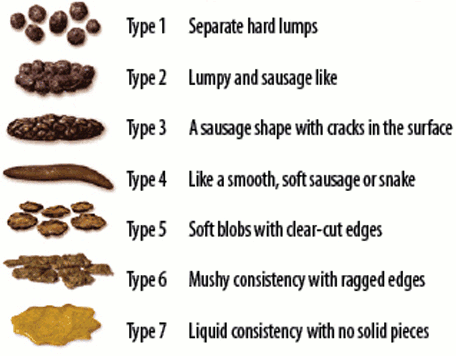Approach
Characteristic history and examination findings are often sufficient to diagnose the condition. Other investigations are unnecessary in the initial assessment.
History
Constipation (difficulty, delay, or distress in defecation) can be present at 3 stages of childhood: in infants at introduction of solids, in toddlers acquiring toilet skills, and at school age.[6]
Symptoms vary from mild and short-lived to severe and chronic, and are sometimes accompanied by fecal impaction, fecal and urinary incontinence, urinary tract infection, and occasionally, abdominal pain. Disease history typically reveals onset of painful defecation with increasing delays from one stool to the next in babies and toddlers (1-2 years of age), with increasing active withholding often at its peak during the 2- to 3-year-old age group.
In older patients, abdominal pain may be related to irritable bowel syndrome, which includes both constipation and abdominal discomfort. The pain in irritable bowel syndrome is not always relieved with clearance of stool.[13]
Refusal to use the toilet is a key element in children 3 to 4 years of age. Overflow fecal retention often temporarily relieved by the passage of very large (toilet-blocking) stools is typical of children over this age. With increasing age, the impacted stool in the megarectum is seldom, if ever, passed and so overflow fecal incontinence is the predominant complaint.
The child's parents or caregivers should be asked about any dietary changes, as these could suggest a food allergy or intolerance as the cause.[13] Other factors that may be associated with the onset of constipation, such as toilet training, introduction of solids, recent school entry, and social stressors, should also be investigated.[4][13]
The Bristol Stool Chart illustrates the consistency of different types of stool and may be a useful resource when taking a patient's history.
[Figure caption and citation for the preceding image starts]: Bristol stool chartWikimedia Commons; Creative Commons Attribution-Share Alike 3.0 Unported [Citation ends].
Physical examination
Inspection of the anus in infancy may reveal abnormal position or appearance (i.e., ectopic or covered). At any age the anus may show evidence of anal fissure as a cause of the painful defecation, or intense erythema characteristic of streptococcal infection. Fissures that extend beyond the anal canal and are not restricted to the immediate anterior or posterior position, and lacerations or bruising, should alert suspicion of child sexual abuse.
Inspection of the abdomen may reveal mild or lower abdominal distention from either the loading of the megarectum or large bladder as evidence of lavatory avoidance. Palpation of the abdomen in constipated children reveals a central mass arising from the pelvis often to above the umbilicus. However, stools that have been effectively softened by medication may be impossible to feel, and so this sign of retention may be missed. The abdomen can also be tender to palpation with significant stool retention. For constipation with no underlying etiology, the child is usually otherwise healthy, although decreased appetite is common in children who have significant stool loading. In some cases of severe constipation, children may experience vomiting when rectally impacted.
Height, weight, and head circumference measurements should be taken, as abnormal growth parameters may indicate an organic cause (e.g., hypothyroidism or cystic fibrosis).[13]
A full neurologic exam should be completed, including examination of the lower back and deep tendon reflexes, to evaluate for a neuropathic cause of the constipation including a tethered spinal cord.
Other tests
Further investigations may be required in children with red flag signs or symptoms. These include abnormal findings on neurologic exam (e.g., decreased lower extremity reflexes or tone), abnormal growth parameters, severe abdominal distention, and a history of intermittent diarrhea and explosive stools. Referral to a pediatric gastroenterologist is recommended in these circumstances.[13]
Do not routinely obtain abdominal radiographs, colonic transit studies, or abdominal ultrasound to confirm the diagnosis.[13][32][33][34]
Abdominal radiographs may be considered in patients with red flag signs or symptoms suggesting an organic cause for the constipation (e.g., abdominal distension, abnormal findings on neurologic exam, intermittent diarrhea and explosive stools, occult blood in stool) or as part of specialist ongoing management of intractable idiopathic constipation.[13][32] It may also be useful if a rectal exam is required (e.g., suspected fecal impaction) but not desirable (e.g., in a child with a history of trauma) or for monitoring purposes posttreatment.[13][33] Colonic transit studies may be helpful as part of specialist ongoing management of intractable idiopathic constipation.[32] They may also be considered to discriminate between functional constipation and functional nonretentive fecal incontinence and in situations in which the diagnosis is not clear.[33]
Contrast enema is useful to evaluate the rectal diameter and investigate the presence of fecal impaction. It may also help rule out anatomic abnormalities such as mucosal intussusception, sigmoid volvulus, and solitary rectal ulcer.[35][36]
Rectal suction biopsy and anorectal manometry can be used to exclude the possibility of Hirschsprung disease.
Lack of high amplitude propagating contractions on colonic manometry can be helpful in identifying patients with constipation refractory to medications who may benefit from surgical intervention.
Psychological assessment can be used to guide effective management, especially in cases with a strong behavioral component or with anxiety as a contributor.
One review found insufficient evidence for a diagnostic association between clinical symptoms of constipation and fecal loading on abdominal radiograph and colonic transit time, and rectal ultrasound, but these tests may be useful in specific situations.[37]
Use of this content is subject to our disclaimer